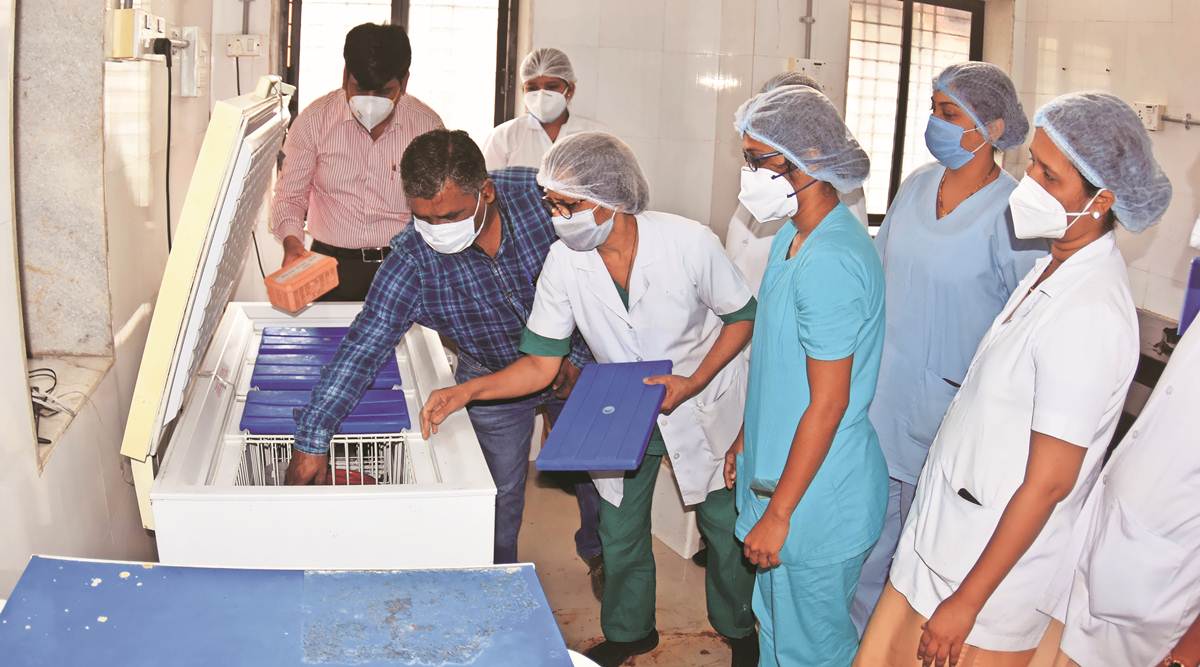 At a proposed vaccine centre at C V L Hospital in Thane on Wednesday. (Express photo by Deepak Joshi)
At a proposed vaccine centre at C V L Hospital in Thane on Wednesday. (Express photo by Deepak Joshi) * Setting up of additional 19 vaccine stores in remote terrains like Ladakh or those with poor logistical support like Northeast states, followed by cold chain testing at the stores
* Vaccine dry run in at least one vaccination centre in every district of the country to assess the load on the flagship Co-WIN IT platform (the Covid Vaccine Intelligence Network, which will have all required information regarding the vaccination drive)
* Additional training to vaccinations team based on the feedback received from the dry run
These are the three tasks that will be undertaken by stakeholders at the Centre and state levels in the 10-odd days before the largest immunisation drive in the country is rolled out, against Covid-19. On Tuesday, the Union Health Ministry said it was prepared to start vaccinating priority groups within days, though the final decision rests with the Centre.
Top government sources, who are part of the team monitoring preparations for the rollout, said they needed the time to iron out any glitches. A source pointed out, “It has to be clarified that when we said 10 days, it means we need a minimum of 10 days. This could be longer too. However, it cannot be less than 10 days.”
One of the primary tasks before the rollout is setting up of additional cold chain and storage points. As the official said, while a system is already in place due to the Universal Immunisation Programme (UIP), with Covid-19, they are looking at not just larger numbers but a vaccination drive that might last through the year. “In the coming days, the vaccine will be procured and transported to the four GMSD (Government Medical Store Depots, located in Karnal for the northern region, Mumbai for west, Chennai for south and Kolkata for east), run by the Centre, and to the 37 state vaccine stores, apart from the 19 additional state vaccine stores.”
The additional stores will come up in regions like Nagaland, which currently receive the vaccines covered under the UIP from Kolkata. Vaccine manufacturers are responsible for the delivery. Ladakh now has a local vaccine store too, as does Srinagar.
Sources said these extra stores will be up and running in three-four days, including testing to see working of the cold chain and their temperature loggers.
The officials will also use the coming days to conduct more dry runs across the country (two have been held already, monitored by the Centre), including on January 8. “Last time (on January 2), 130-odd districts were involved. Now we are planning to have a site each in all the 700-plus districts, to examine what kind of load it generates on the Co-WIN digital platform,” sources said.
Additional training of vaccination teams has started to fills gaps found during the previous dry runs. An official said, “The operation guideline itself is an 108-page document, and there were certain things they missed. We communicated with the teams regarding specific paragraphs.”
Health Secretary Rajesh Bhushan Tuesday said that Saturday’s dry run, at 286 session sites, had looked at four areas: “operational feasibility of Co-WIN in large-scale use; linkages between planning, implementation, and reporting mechanisms; challenges; and providing confidence to programme managers at various levels”. He said it was based on this feedback that they announced that the vaccine rollout could begin 10 days from the grant of emergency use authorisation to the Serum Institute of India’s Covishield and Bharat Biotech’s Covaxin, which was given on January 3.